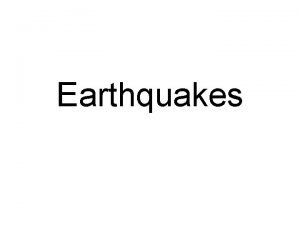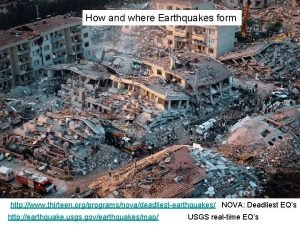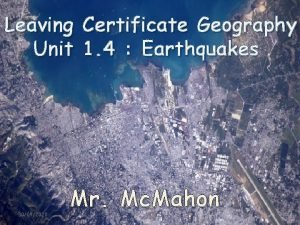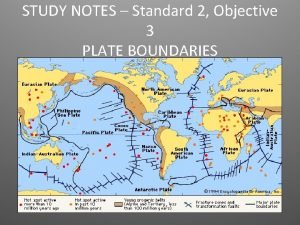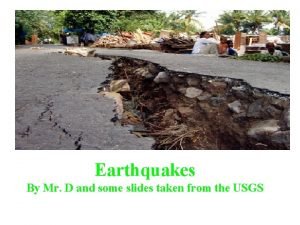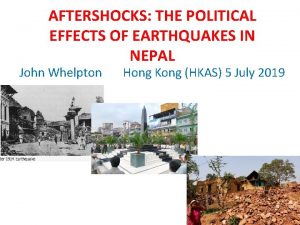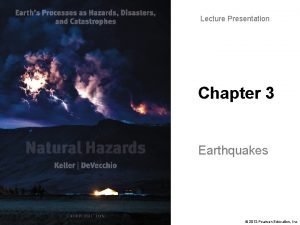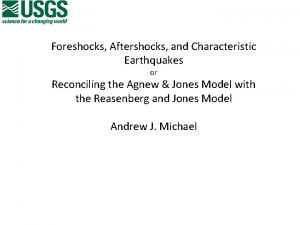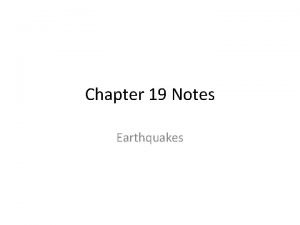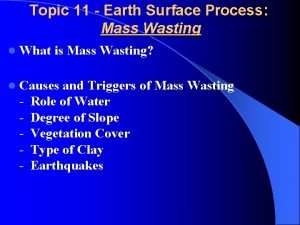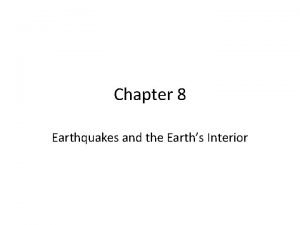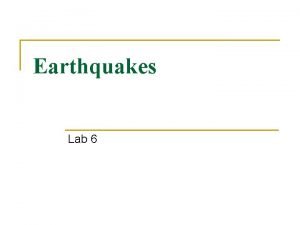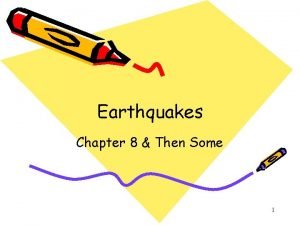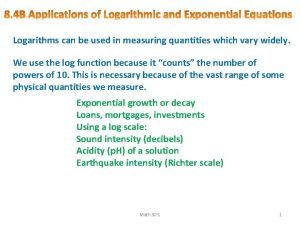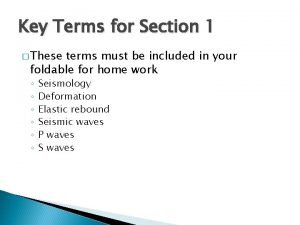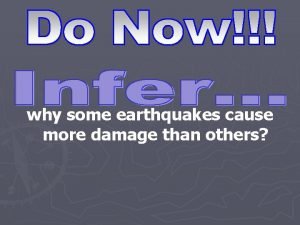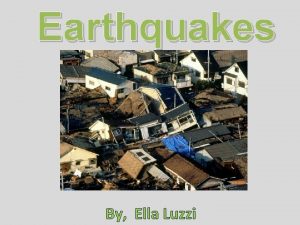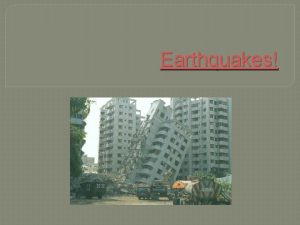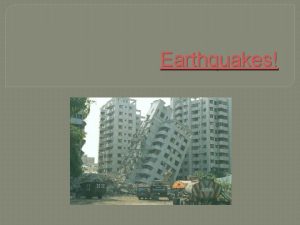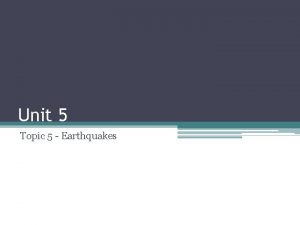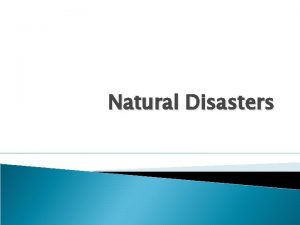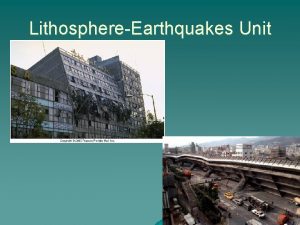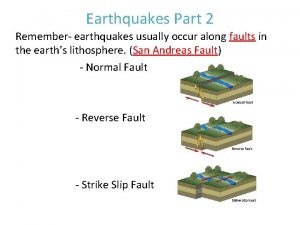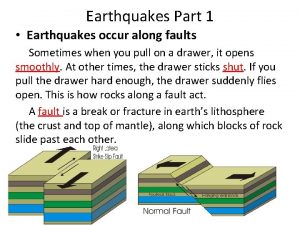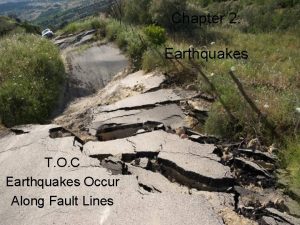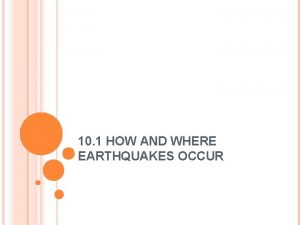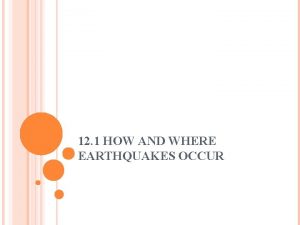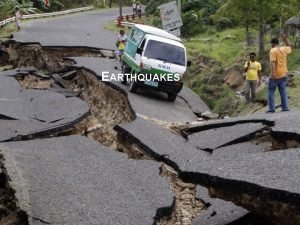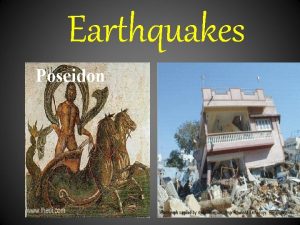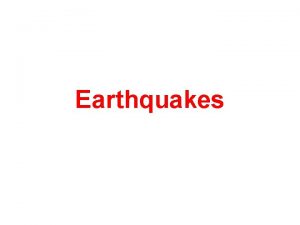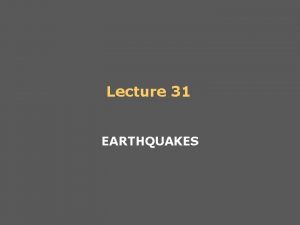Earthquakes Where do Earthquakes occur 28Lithosphere What causes























- Slides: 23

Earthquakes

Where do Earthquakes occur? • 28)Lithosphere

What causes Earthquakes? • Earthquakes occur where tectonic plates are moving. • They can move towards each other, away from each other, or horizontally beside each other.

#29 Geologists analyze earthquake waves (seismic waves) to determine the composition of the layers within Earth.

Transform – San Andreas Fault

What would you do? • 39) If you were inside a building, the best thing to do when an earthquake occurs is immediately hide under a desk or chair. • Something strong to cover your body.

What would you do? • If you are outside when an earthquake begins, you should? Run away from buildings!!!!!

• A seismograph is a machine that measures earthquakes.

• A seismogram is a tracing of earthquake motion created by a seismograph.

Earthquake: Epicenter & Focus - The location where the earthquake begins and rocks being moving. The ground ruptures at this spot, then seismic waves radiate outward in all directions. Epicenter - The point on the Earth's surface located directly above the focus of an earthquake.

Epicenter & Focus

Waves and Energy Seismic Waves—A type of vibration that travels through the Earth 3 Types: 1. Primary (P) waves 2. Secondary (S) waves 3. Surface waves

Primary (P) waves • Fastest waves!!! • Travel through solids, liquids, and gases • A type of seismic wave that compresses and expands the ground. • The first wave to arrive at an earthquake. • Least Destructive

Surface waves • Move along Earth’s surface, not inside! • Travel slowest! • Most destructive

Secondary (S) waves • Slower than P waves • Pass through solids only (can’t move through liquid outer core) • A type of seismic wave that moves the ground up and down or side to side

Comparing P & S Waves

Remember difference between waves? • P wave is the fastest wave and least destructive! • The Surface wave is the slowest wave and the most destructive. • S wave is not the fastest or slowest, it is in the middle!

Shadow zone • 36)A shadow zone is formed on the opposite side of the Earth from where the earthquake occurred because S waves are blocked by liquid.

Tsunami

How often does an earthquake occur measuring 7. 2 on the Richter scale, based on the information below? How often does an earthquake measuring 3. 3 occur on the Richter scale? Descriptor Magnitude Average occurring annually Great 8. 0 and higher 1 Major 7. 0– 7. 9 18 Strong 6. 0– 6. 9 120 Moderate 5. 0– 5. 9 800 Light 4. 0– 4. 9 about 6, 200 Minor 3. 0– 3. 9 about 49, 000 Very minor 2. 0– 2. 9 about 365, 000

Why do Scientists KNOW the Earth has a liquid layer? #35 S waves are blocked by liquid. Since seismographs on the opposite side of the Earth do not receive any S waves after an earth quake so scientists have concluded that the Earth has a liquid layer

Earthquake Magnitude using Richter Scale Measures earthquakes using a scale of 1 -10. Moves up 1 number = an increase of almost 32 times more energy • Example: magnitude 5 earthquake = almost 32 times more energy than a magnitude 4

How are Earthquakes Measured? Richter Scale
 Where do earthquakes occur? *
Where do earthquakes occur? * Why do earthquakes occur
Why do earthquakes occur Causes of earthquake in points
Causes of earthquake in points Causes of earthquake
Causes of earthquake Proximate and ultimate behavior examples
Proximate and ultimate behavior examples Ultimate vs proximate causation
Ultimate vs proximate causation Epicenter of earthquake
Epicenter of earthquake Frequent earthquakes in an area may indicate *
Frequent earthquakes in an area may indicate * Chapter 8 section 3 earthquakes and society answer key
Chapter 8 section 3 earthquakes and society answer key Types of earthquake
Types of earthquake Earthquakes
Earthquakes A large crack in the earth formed by a river or earthquakes
A large crack in the earth formed by a river or earthquakes Pearson education
Pearson education Earthquakes
Earthquakes Chapter 19 earthquakes
Chapter 19 earthquakes Explain natural disasters
Explain natural disasters Mass wasting processes
Mass wasting processes Chapter 8 earthquakes and earth's interior
Chapter 8 earthquakes and earth's interior In what section of earth do earthquakes happen?
In what section of earth do earthquakes happen? Diastrophism meaning
Diastrophism meaning Chapter 8 quiz 1
Chapter 8 quiz 1 Http://earthquake.usgs.gov/earthquakes/map/
Http://earthquake.usgs.gov/earthquakes/map/ Elastic rebound
Elastic rebound Why some earthquakes cause more damage than others
Why some earthquakes cause more damage than others
